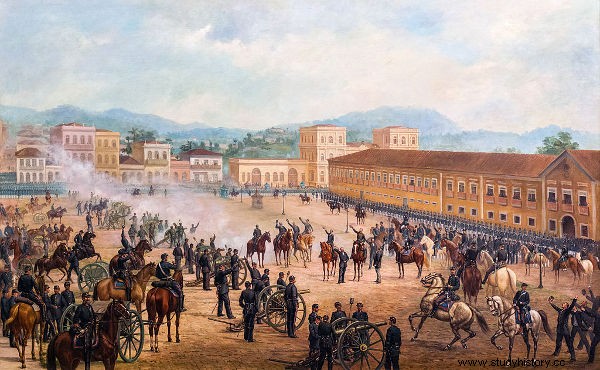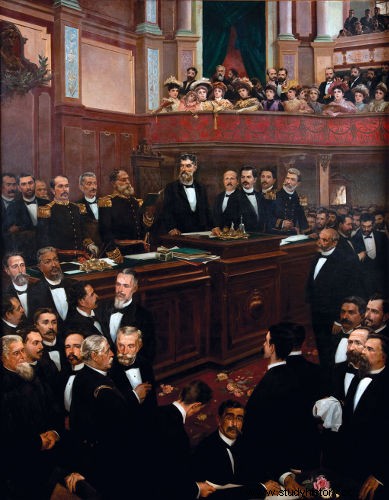The Constitution of 1891 it was the first Brazilian document of its kind in the republican period. The elaboration of this Charter was the result of the change in the form of government in our country due to the Proclamation of the Republic, an event that took place on November 15, 1889. It was the second Constitution in Brazilian history and brought numerous changes.
Through it, the republic was ratified in Brazil; the federalist system was implemented, which generated great autonomy for the Brazilian states; presidentialism was established with elections held every four years; the State was separated from the Church; and male suffrage was instituted, but with the illiterate still excluded.
Read more :War of Paraguay – the war that marked the break of the Army with the monarchy
Republic in Brazil

The Constitution of 1891 was a direct consequence of the implementation of the republic in Brazil. This form of government was established here through a coup held on November 15, 1889 . The Government Provisional , established since that date, needed legal mechanisms to support it, and therefore a new Constitution was written.
The institution of the Brazilian republic was the result of the erosion of the bases that supported the monarchy in power. The group most dissatisfied with her were the military, as they did not feel valued enough. In addition, they defended ideals that preached the transformation of Brazil into an authoritarian republic so that economic modernization could take place.
As the 1880s progressed, support for the monarchy weakened to the point where the military began plotting to overthrow Emperor d. Peter II. Politically there was a great dissatisfaction with the centralization of power in Brazil, and the defense of federalism began to gain strength.
The conspiracy against the monarchy united civilians and military personnel until, in November 1889, the coup was carried out and included influential figures of the time, such as Benjamin Constant and Deodoro da Fonseca . At the end of November 15, 1889, Joseph from Sponsorship proclaimed the republic in the City Council of Rio de Janeiro.
Transition to the republican model
Shortly after the Proclamation of the Republic, the royal family was expelled of Brazil and a Provisional Government was organized. It was the responsibility of this government to make the transition to the republican model, promoting the main changes necessary to consolidate the republic. The members of that government were divided between those who defended a government authoritative and those who advocated a government liberal , with an emphasis on guaranteeing individual freedoms.
The Marshal Deodoro da Fonseca , an influential name in the Army at the time, and one of the drivers of the November 15 coup, was nominated to be the president of Brazil on a provisional basis . This transitional government sought to maintain public order and create symbols that would refer to the new form of government.
These new symbols they would serve to emphasize republican values and impregnate them in the popular imagination of Brazilians. Thus, toponyms (names of public places) were replaced, the flag was modified, new personalities became “heroes of the homeland” and, naturally, it was necessary to change the Constitution.
To guarantee the new Constitution, it was necessary to form an Assembly Constituent , the institution formed by deputies and senators who would draft the new Charter. The election for the Constituent Assembly was held in September 1890, and the result of it delimited the face of this body:elitist .
The Constituent Assembly worked on the drafting of the new Charter for three months and carried out its enactment on February 24, 1891 . As part of its work, an indirect presidential election was held. The two main candidates for the presidency of Brazil in this election were:
-
Deodoro da Fonseca :129 votes
-
Prudente de Morais:97 votes
The presidential election also included the vote for vice president, and of that race, the two main candidates were:
-
Floriano Peixoto :153 votes
-
Eduardo Wandenkolk:57 votes
Thus, those elected were:Deodoro da Fonseca, for president, and Floriano Peixoto, for vice-president. With the election of two different candidates, a scenario of tension was established that extended through the first years of the republic in Brazil:the rivalry between “deodorant ” and “florianists .”
Login also :Segundo Reinado – a summary of the events of the reign of d. Pedro II
Basic Elements of the 1891 Constitution

The Constitution of 1891, after its promulgation, became the first of the republican period in Brazil. It consisted of 91 articles and had another eight transitional articles , with a certain validity. This document consolidated profound changes in the country and was inspired by the United States Constitution .
The first point we should focus on is that, based on it, the republican system in Brazil was confirmed. The presidentialism was chosen as the system of government, with direct election as the stipulated way of choosing the president. The name of the country was defined as “United States of Brazil ” (it was written “Brazil” at the time).
The 1891 Constitution reinforced liberalism , more in the sense of individual liberties, as an ideological principle that guided part of the groups in power. Through this document, the old demand of the country's regional elites was met:the decentralization of power took place with the implementation of federalism.
In short, federalism is a political system characterized by the union of federations that form the Nation, but within a structure that guarantees autonomy policy for states and municipalities. Thus, power is decentralized in it, and states and municipalities gain political power. This system, at the time, allowed the colonels , men with great economic power, could expand their activities in the regions they inhabited.
States were able to guarantee themselves a lot of autonomy, and this allowed them to create taxes, formulate their own laws, own property over natural resources in their territories, etc. Finally, the government of states, like the government of the Nation, would be defined by an election. Federalism allowed the expansion of the influence of oligarchies in the Brazilian countryside.
Characteristics
As the Constitution of 1891 was marked by liberal influence, there was a certain guarantee of liberties individuals , such as those of expression, meeting and worship, and the right to private property was reinforced, for example. This document was also notable for including the right of habeas corpus , something that did not exist in the Constitution of 1824.
The fourth power that existed in Brazil during the monarchy (Moderating Power) was abolished and the principle of three was adopted powers — Legislative, Executive and Judiciary. Separated State and Church , consolidating secularism as the fundamental foundation of the Brazilian State.
Politically many changes have taken place. The office of president was instituted and that of prime minister was abolished. The positions of president and vice were determined to be four years in duration , and there would be no possibility for reelection. However, no mechanism was created to guarantee the fairness of the electoral system, which contributed to the fact that the fraud electoral established itself as a major electoral practice in Brazil in the First Republic.
The suffrage has been established male , although there were a number of limitations on male access to the vote. As women did not have the right to vote . Finally, when it comes to the issue of social rights, the 1891 Constitution was silent. There was nothing to that effect, a clear indication of the elitist bias of its writers. Newly freed blacks, for example, received no guarantees or assistance.
Login also :Could slavery have been abolished before 1888?
Right to vote
With the Constitution of 1891, the census vote came to an end . The income criterion was no longer used to define who would have the right to vote, and male suffrage was established. Thus, whoever was over 21 years old could vote, as long as they were not homeless, illiterate, low-ranking military or religious with a vow of obedience.
These criteria demonstrate the interest of the drafters of the Constitution in promoting the exclusion of the lower social strata of the most basic right of citizenship:the vote. In addition, women are not mentioned as holders of this right, an indication that they were not seen as citizens.
With this, we realized that, although there was literally no income criterion to guarantee the right to vote, the drafters of the Constitution imposed criteria that excluded a large part of the population, maintaining this right as a privilege of a minority.
Image credit
[1] Commons
